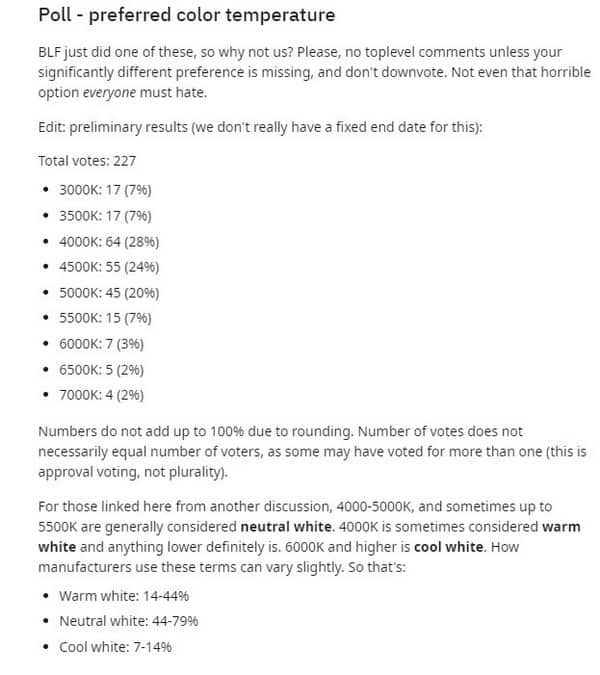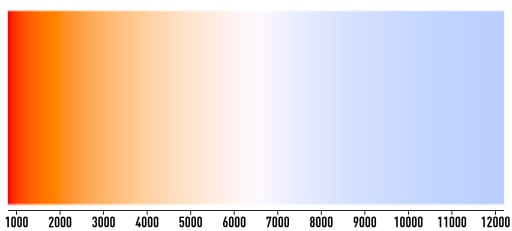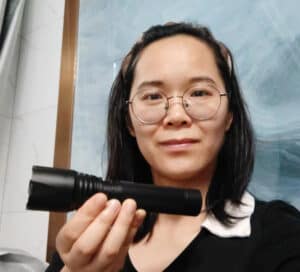When we talk about the light of the flashlight, we usually refer to color temperature and CRI. Light color temperature and color rendering index (CRI) are two important characteristics of a flashlight. Understanding these properties can help you choose a flashlight that meets your needs.
What is color temperature?
The color temperature is the measure of the hue of a particular light source. It is expressed in degrees Kelvin (K) and is based on the temperature at which a theoretical black body radiator would need to be heated to produce the same hue as the light source.
Why do people use temperature to describe light? The term comes from the physics community. When a piece of iron is heated, it changes color according to the temperature at which it is heated. When the iron becomes hot enough, it begins to glow red, orange, white, and then blue. Even after the iron melts and you continue to heat it, the color of its glow changes constantly with the temperatures. Light is the same, different temperatures show different colors.
The color temperature categories.
The light temperature has three main categories: warm, neutral, and cool.
Warm light temperatures range from 2700K to 3200K and have a yellow or orange hue and inviting atmosphere.
Neutral light temperatures ranging from 3200K to 5000K have a white or blue-white hue.
Cool light temperatures range from 5000K to 6500K and have a blue or blue-white hue.
The color temperature is lower numbers indicating warmer, more yellow or orange hues, and higher numbers indicating cooler, more blue hues.
Here is a table for the reference of the color temperature from Wiki.

You will find the terms “cool” and “warm” concerning color temperature can easily be misleading. Because as the color temperature of the light goes up, the hue gets bluer. It seems contrary to human intuition that light with a lower color temperature is called warm light, and light with a higher color temperature is called cool light. But this stems from the fact that people traditionally refer to yellow as warm and blue as cool.
Use of color temperature.
Warm light is often used in settings where a cozy or relaxing atmosphere is desired, such as in a tent. It is also often used for tasks that require precise color matching, such as makeup application or painting.
Neutral light is a versatile light temperature that is suitable for a variety of tasks and settings. It is often used in work environments because it provides good visibility without causing eye strain. It is also commonly used in photography and video because it allows accurate color representation.
Cool light is often used when a bright and energetic atmosphere is desired. It is also often used for tasks that require high levels of visibility, such as reading or outdoor activities.
What’s the best color temperature for a flashlight?
There is a poll on Reddit.

We can see 72% of people prefer flashlights with a neutral color temperature from 4000K to 5000K.
Generally speaking, warm color temperature LEDs are more suitable for close operation and color discrimination, and cool color temperature light LEDs are more suitable for illuminating distant places. Cool lights are also good for night vision because human eyes respond faster to cool light in the dark.
By the way, the sunlight at noon is approximately 5000K. So if you are looking for nature, 5000K is the best option.
So, 6500K color temperature flashlights can make you feel brighter and see more clearly, so many people also like the color temperature at 6500K.
In fact, most flashlight in the market is with 6500K cool color temperature. Flashlights with a high color temperature are often preferred for tasks that require a lot of detail work, such as reading or repairing, as the cooler light can help to reduce eye strain and fatigue.
What’s CRI?
CRI is short for Color Rendering Index. CRI is a quantitative measure of the ability of a light source to reveal the colors of various objects faithfully in comparison with a natural or standard light source. (According to Wiki).
CRI is marked as a number. CRI is rated on a scale of 0-100, with higher numbers indicating better color rendering. A light with a high CRI will show the colors of objects more accurately, while a light with a low CRI may cause colors to appear distorted or unnatural. When CRI is 0, all the colors look the same. CRI of 100 means the true colors of the objects, and the human eye to distinguish the color of the thing easily.
Daylight is the ideal light source because the object’s color under daylight looks natural. And we can easily distinguish the subtle differences between each color. So usually, people consider the CRI of daylight to be 100.
Rate of CRI and their general application
90-100: 1A Excellent Where accurate color contrast is required.
80-89: 1B / Where correct color judgment is required.
60-79: 2 Normal Where medium color rendering is required.
40-59: 3 / Where the requirement for color rendering is low, and the color difference is small.
20-39: 4 Poor Places with no specific requirements for color rendering.
For LED flashlights, the higher the CRI value, the softer and more comfortable the light source is. High CRI value LED flashlights can reduce visual fatigue, make the vision clearer, make the image more three-dimensional, and bring users a high display and lightweight outdoor lighting experience. The CRI of an ordinary LED flashlight is around 65-75. The quality of LED bulbs has improved significantly in recent years, and some newer LED flashlights have a CRI of 90 or higher. No doubt, if a higher CRI is required, the cost may increase considerably.
For easy understanding, the following apple images show an example of the same apple under the same color temperature but with a different CRI.

Relation between color temperature and CRI.
The color temperature and CRI are two separate parameters for the light. Color temperature and CRI are two important factors to consider when choosing a light for a space.
Color temperature refers to the appearance of the light produced by a lamp or light source. On the other hand, CRI, or Color Rendering Index, refers to the accuracy with which a light source can reproduce the colors of objects that it illuminates.
While color temperature and CRI are related, they do not directly impact each other. A light source can have a high color temperature and a low CRI, or vice versa, which means, for a temperature color such as 5000K, the CRI can be 75 or 80.
But generally, the warmer the light color, the better CRI. Because White LED light-emitting principle is that the electrons through the chip emit blue light, and then an excited phosphor emits yellow light, mixed into white light, which phosphor excited yellow light color rendering is relatively high. In contrast, blue light is monochromatic, so to improve the color rendering must increase the proportion of yellow light.
Then again, the warm light color temperature is low, with longer wavelengths, in the rain and fog weather penetration stronger irradiation farther, these characteristics together determine the need for outdoor sports warm light LED.
But on the other hand, the efficiency of the excitation fluorescence is relatively low, and the total brightness of the warm white LED will be lower. At the same time, the light color appears to be dimmer. So a comprehensive view of outdoor sports in the choice of white LED products is more appropriate. Both have good color rendering and penetration but also avoid severe brightness reduction and staining phenomena.
How to select the color temperature and CRI for your flashlight?
When selecting the color temperature and CRI for your flashlight, there are a few factors to consider:
1. Purpose of the flashlight: If you use the flashlight for tasks requiring accurate color rendering, such as painting or identifying colors in a dark environment, you will want to choose a flashlight with a high CRI. A CRI of 90 or higher is generally considered suitable for color rendering.
2. Personal preference: The color temperature of the flashlight can affect the ambiance of the space and your mood. If you prefer a warm, cozy atmosphere, choose a flashlight with a low color temperature (below 3,000 K). If you prefer a brighter, more energetic atmosphere, choose a flashlight with a higher color temperature (above 5,000 K).
3. Battery life: A flashlight’s color temperature and CRI can also affect its battery life. Lights with a high color temperature and CRI may require more power and shorter battery life. Consider this factor if you are using the flashlight for extended periods.
Overall, when selecting the color temperature and CRI for your flashlight, consider the purpose of the flashlight, your personal preference, and the battery life. Concerning these factors, you can choose a flashlight that meets your needs and preferences.



38 Responses